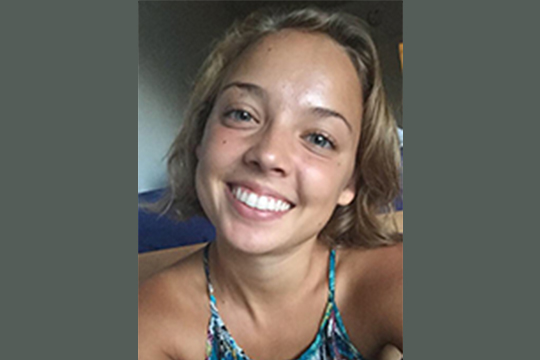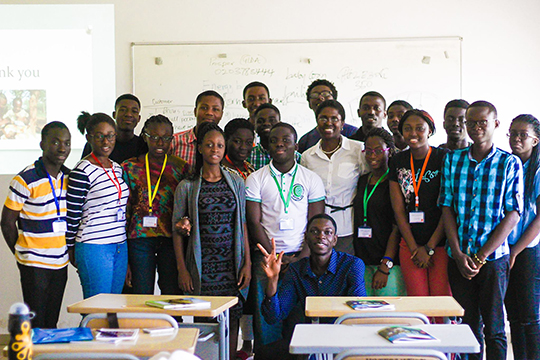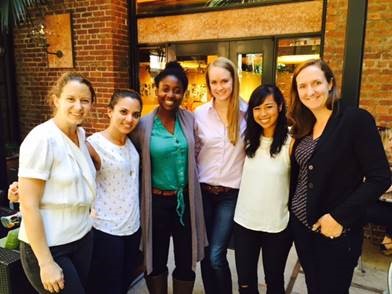Category: Education and Youth Development

Investing in Bhutan’s youth
By Tim Huang, ’14 (B.A. Human Biology; M.A. Education)
I was drawn to the Himalayan Kingdom of Bhutan because of my interest in how the young democracy in transition was thinking differently about sustainable development and the well-being of its people. Thanks to a Haas summer fellowship, I spent two consecutive summers in college implementing a youth employment project with a local nonprofit, the Bhutan Youth Development Fund. After graduating from Stanford, I returned to Bhutan through the Omidyar Network International Public Service Fellowship, one of the Haas Center’s postgraduate fellowships. During my fellowship year, I worked to strengthen educational equity as a researcher for the Royal Academy, His Majesty the King’s Secretariat. I have since served as a Program Officer at the Bhutan Youth Development Fund, organizing child protection and youth empowerment programs with partners like UNICEF. Over the last 3 years, working in Bhutan has reinforced my belief that investing in the promise of our children and youth creates a more just and sustainable world.

From Sequoia to Spain
By Celina Jackson, ’17 (Comparative Studies in Race and Ethnicity)
After fifth period comes to a close, I sit down with Mr. Rosario to debrief his English Support class — I volunteer there, at Sequoia High School, through the Haas Center’s High School Support Initiative. During the one hour and forty minute period I typically work with individual students, discussing their literary analyses of Richard Wright’s Black Boy and helping them pick apart the meanings of certain passages. I follow Mr. Rosario’s lead in encouraging students to find parallels between the life of the narrator – a black boy in the early 20th century south – and their own lives as mostly low-income Latinx students in the Bay Area in 2017. On the scenic drive back to Stanford along Alameda de las Pulgas, my carpool buddy and I chat about how difficult teaching is, our burning frustrations with the education system, and the inspiring moments when we connect with students or witness them realizing, “I get it.”
Over the past quarter, Mr. Rosario and his ninth graders have made my Tuesday afternoons joyful, challenging, and always energizing. The experience has been deeply rewarding for me on both a personal and a career level – I will be joining the teaching field next year on a Fulbright grant in Spain! – and I am extremely grateful for the opportunity to participate.
Celina is a student leader for the Haas Center’s High School Support Initiative, a program that allows students to work with underserved youth at local high schools.

Finding the “why”
By Charlene Chambliss, ’17 (Psychology)
As soon as I mentioned that I was a Psychology major, Maria began excitedly peppering me with questions about the cultural psychology of South Korea, a culture she had come to be fascinated with through her love of K-pop and other Korean music. Time flew as I explained what I knew about how cultural norms develop differently in different societies, and I enthusiastically introduced her to many of my favorite methods for exploring a new subject online and by getting cheap used books through Amazon. When time came for me to go back to campus, I didn’t want to leave—helping empower Maria to feed her curiosity had easily been the most fulfilling thing I’d done all week.
I noticed that many of the students I worked with at Sequoia High School seemed to be “going through the motions” of their classes, following the path that they’ve been put on without a strong sense of purpose. At their age, I had often felt the same way—I had been taught to do well because it would pay off later. These students do want help with their homework, but what they really want is a reason to get excited about learning, a reason beyond “college and a good job” that speaks to their hopes and dreams for the future, and what kind of person they want to become. These youth are impressive—independent, resourceful, and willing to work hard. They’ve got a handle on the “how.” Now, all they need is their “why.”
Charlene is a student leader for the Haas Center’s High School Support Initiative, a program that allows students to work with underserved youth at local high schools.

Using sport to engage youth
By Eric Fabre, ’16 (International Relations)
Applause broke out as Ed Foster-Simeon, CEO at the US Soccer Foundation, closed out the 2016 Soccer for Success National Training. It was the fourth and final day of the event, and the emotion from days of hard work was tangible in the room of this Washington, DC hotel. I had been at the Foundation for only 2 weeks, but in that short time had already witnessed the amount of time and effort that was put into this event. Over 150 people from around the country had flown into DC to learn how to run a local after school soccer program, designed by the US Soccer Foundation and their partner communities. I had been a small part of the implementation of the National Training, and felt humbled to be in the same room as so many people that have been true catalysts for change in their respective communities.
This moment stands out to me from my summer as a Donald Kennedy fellow because I realized that everyone in the room had chosen to use our program to create positive change in their communities. They believed that using sport was the best way to engage youth and affect their lives in a positive way. Seeing the emotion as they watched the final speech and the hugs and handshakes that went around as they said their goodbyes to their fellow coaches told me all I needed to know: this was the work I wanted to do, and I was proud to support these people in their community work.
Eric is a 2016-17 fellowships peer advisor.

A summer of teaching and learning
By Brian Fleischer, ’19 (undeclared)
It was under the hot Accra sun that I realized why I was back home, why I was among this amazing group of students, and why I was doing this work in the first place.
When I received the Donald Kennedy Fellowship to work with high school students to propose and develop innovative solutions to problems they had discovered within their communities, I was still unsure if that was how I wanted to spend my summer. I was also unsure if I would be capable to lead the cohort of peer mentors and generally facilitate this project.
Not long after interacting with these students I realized that this was also a learning experience for me and a chance to immerse myself within and discover myself. I got to know and understand to some extent the various problems these students encountered and marveled at the novelty and practicality of the ideas presented. From “P-Coal,” a greener and cheaper alternative for charcoal made of waste, to “Senior Smile,” a youth movement for the neglected elderly, these ideas proved to the students themselves, their communities, and myself that the youth are indeed central drivers of positive change within their communities.
It was under that hot Accra sun that I realized that I was there to find myself.

“First place—Safe Zone.”
By Po Tsui, ’19 (Symbolic Systems) and Naomi Gregorio, ’19 (Mechanical Engineering)
As the winner was called, Anthony Ramirez, a sophomore from LACES High School, rose in disbelief to his feet. A USC lecture hall filled to capacity—families with young siblings, startup investors from Silicon Valley, media crews, and twenty-nine male high school students from South Central Los Angeles—witnessed as Anthony and his team won $5,000 seed funding for Safe Zone, a start-up mobile application that helps teens connect with doctors and health clinics regarding sexual health with the aim of preventing teen pregnancy and STDs, an issue these inner city youth can personally relate to.
At Teens Exploring Technology, we worked as coaches in the Summer Leadership Coding Academy to teach programming, entrepreneurship, product development, and leadership. Each team pulled all-nighters and struggled throughout the development process as they were constantly dared to break the limits not only of their product, but also of their own personal conviction. With the needs of their community in mind, they designed wireframes, built databases, pitched to investors, and grew to be effective leaders. Whether or not these students’ apps will endure the test of time and transform the world, the true products—their transformed selves—certainly will.

“Shine as if the whole universe is yours”
By Priscila Garcia, Program Director, East Palo Alto Stanford Academy (EPASA), Haas Center for Public Service
During the summer, eight Education and Youth Development Fellowship recipients worked with East Palo Alto Stanford Academy (EPASA) to create engaging, interactive, and thoughtful programming for forty Ravenswood City School District middle school youth. The five-week program included English and Language Arts (ELA), math, and various elective courses. This year’s theme was GalaxEPASA; using Rumi’s quote, “Shine as if the whole universe is yours,” program staff facilitated activities that prompted reflection on the role of the individual within the community. Additionally, every Friday, EPASA went on field trips in the surrounding community—a student favorite was visiting Hidden Villa Farm in Los Altos, where they had the opportunity to make and eat ice cream.

Empowering youth to achieve their dreams through technology
What if there was a summer camp where every day is like a hackathon? Rafael Cosman, ’15, teamed up with two other Stanford students to create CodeCamp, a four-week summer program for high school students in East Palo Alto.
By Van Tran, ’16

Examining environmental issues in the classroom
By Lynne Zummo, MA ’15 (Curriculum Studies and Teacher Education in Science Education)
Their big smiles and enthusiastic shouts say it all—kids love learning at NatureBridge. From my first observation of students at the Golden Gate campus, which overlooks Rodeo Beach and the steep cliffs of the Marin Headlands, I knew that NatureBridge was a special place. Wandering along the ocean and through densely forested groves, children here are happy and excited to learn about the natural world. One hope of NatureBridge is that this enthusiasm for nature persists beyond the residential experience, as students return to classrooms.
Having taught science, I endeavored to work with NatureBridge to develop a standards-based curriculum that could be given to schools to implement in the classroom, following field trips. Collaborating with the staff at NatureBridge, as well as local teachers, I developed a curriculum focused on connecting students’ NatureBridge experience to their daily lives. This interdisciplinary curriculum seeks to help students understand water issues in California through multiple academic lenses. Building on knowledge and experience gained during at NatureBridge, the curriculum helps students examine a relevant issue from many perspectives. We plan to pilot the curriculum next spring—I hope that it makes a meaningful contribution to both NatureBridge and local students.

Eliminating the opportunity gap
By Arnelle Ansong, ’18
I began noticing income disparity when I was a student at my middle school, which pulled students from cities and suburbs throughout the county. The realities of income disparity became even more obvious in high school, where students across the income bracket took classes together.
My interest in economic and educational inequity fed perfectly into my summer at Wishbone, an organization devoted to eliminating the opportunity gap. Wishbone helps low-income high school students find quality summer programs, empowers them to raise funds, and provides scholarships for unmet need.
To meet the needs of the organization’s rapid expansion, I collected information on existing programs in Wishbone’s Connecticut, San Francisco, Los Angeles, and New York regions. After gathering this network of programs, I updated Wishbone’s online database so that more students can access programs that suit them.
A visit to an engineering camp in San Francisco affirmed for me the significance of my work. There I met Jenny, who had almost no experience with electronics. During her summer, however, she learned enough to create solar-powered speakers!
Quality summer programs like these give students the opportunity to develop their passions. Everyone deserves access, and this summer gave me the space to explore and expand on my own passions.
